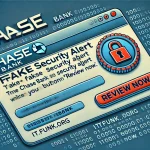The “Capital One – Unusual Spending Activities Detected” scam email is part of a phishing campaign targeting unsuspecting individuals. Disguised as a fraud notification from Capital One, a legitimate financial institution in the United States, this email is designed to manipulate recipients into revealing sensitive information or taking harmful actions.
What Is the “Capital One – Unusual Spending Activities Detected” Email Scam?
The phishing email falsely claims to be from Capital One’s fraud monitoring department, alerting the recipient of unusual spending on their account. It warns of account restrictions unless immediate action is taken. The email includes a link labeled “View Your Message,” which redirects users to a malicious website that closely mimics Capital One’s legitimate platform.
Remove annoying malware threats like this one in seconds!
Scan Your Computer for Free with SpyHunter
Download SpyHunter now, and scan your computer for this and other cybersecurity threats for free!
Objectives of the Scam
The primary goal is to trick users into entering their Capital One login credentials or other sensitive information, enabling cybercriminals to:
- Steal funds
- Commit identity theft
- Access other linked accounts
- Send phishing emails from the victim’s account to propagate the scam further
Threat Summary
The table below summarizes key details of the “Capital One – Unusual Spending Activities Detected” email scam:
| Category | Details |
|---|---|
| Threat Name | Capital One – Unusual Spending Activities Detected Email Scam |
| Threat Type | Phishing, Scam, Social Engineering, Fraud |
| Fake Claim | Unidentified spending pattern detected |
| Related Domain | clearlivate[.]com |
| Detection Names | alphaMountain.ai (Spam), CyRadar (Malicious), Fortinet (Spam), Kaspersky (Phishing) |
| Disguise | Notification from Capital One |
| Symptoms | Generic greeting, urgent language, suspicious links, grammatical errors |
| Distribution Methods | Deceptive emails, rogue pop-up ads, search engine poisoning, misspelled domains |
| Damage | Loss of sensitive private information, monetary loss, identity theft |
| Danger Level | High |
Remove annoying malware threats like this one in seconds!
Scan Your Computer for Free with SpyHunter
Download SpyHunter now, and scan your computer for this and other cybersecurity threats for free!
Detailed Analysis of the Scam
Symptoms of Infection
Although this phishing campaign primarily uses deceptive emails, falling victim to it can result in broader system vulnerabilities. Signs that your device or accounts have been compromised include:
- Receiving notifications of unauthorized account access.
- Unexplained transactions in your bank account.
- Unusual activity or password reset requests for online accounts.
- Pop-ups or ads appearing frequently on your device (malware infection).
Distribution Methods
- Phishing Emails: The primary method, where fraudulent emails mimic Capital One’s official communications.
- Rogue Pop-Up Ads: Clicking malicious ads can redirect users to phishing pages.
- Search Engine Poisoning: Using search engines to promote fake websites that appear legitimate.
- Misspelled Domains: Links with slight variations of legitimate domain names, such as “capital0ne.com.”
Damage Potential
Victims of this scam may face:
- Financial Loss: Theft of funds from compromised accounts.
- Identity Theft: Use of personal details for fraudulent purposes.
- Reputational Damage: If the attacker uses the victim’s accounts to spread phishing emails or malware.
How to Remove Malware?
Remove annoying malware threats like this one in seconds!
Scan Your Computer for Free with SpyHunter
Download SpyHunter now, and scan your computer for this and other cybersecurity threats for free!
If your device has been compromised due to interaction with this scam, follow these steps to remove malware effectively:
Step 1: Download and Install SpyHunter
- Download the installer.
- Run the installer and follow the on-screen instructions to complete the setup.
Step 2: Perform a Full System Scan
- Open SpyHunter after installation.
- Click on “Start Scan” to initiate a comprehensive scan of your system.
- Wait for SpyHunter to detect any malicious files, adware, or suspicious programs.
Step 3: Review Detected Threats
- Once the scan is complete, review the list of detected threats.
- Pay attention to any malware or programs linked to phishing activities.
Step 4: Remove Detected Malware
- Select all the threats you want to remove.
- Click on the “Fix Threats” button to quarantine or eliminate them.
Preventive Methods to Avoid Future Infections
- Be Cautious with Emails:
- Verify the sender’s address.
- Avoid clicking links or downloading attachments from unknown sources.
- Check for generic greetings, grammatical errors, or unusual urgency.
- Enable Two-Factor Authentication (2FA): Use 2FA on all sensitive accounts for an added layer of security.
- Install Anti-Malware Software: Reliable tools like SpyHunter can detect and block malicious activities.
- Update Software Regularly: Keep your operating system and applications up-to-date to patch vulnerabilities.
- Use Strong, Unique Passwords: Avoid reusing passwords and consider using a password manager.
- Monitor Accounts: Regularly review account activity for unauthorized transactions or changes.
- Avoid Rogue Ads and Pop-Ups: Refrain from clicking on ads from unknown or suspicious websites.
Remove annoying malware threats like this one in seconds!
Scan Your Computer for Free with SpyHunter
Download SpyHunter now, and scan your computer for this and other cybersecurity threats for free!




